
The manufacturer Thermaltake was founded in Taiwan in 1999 and develops, produces and sells processor coolers, power supplies and computer cases of all kinds worldwide. There is probably no hardware enthusiast who does not know the name Thermaltake. Since its founding, the manufacturer never tires of developing new and visually striking products. Of course, AiO water cooling systems have also been part of the portfolio for quite some time. This was now expanded at the end of September with the TH V2 ARGB and TH V2 Ultra ARGB series. Therefore, we have the Thermaltake TH280 V2 ARGB in the test for you today.
As you can guess from the name, the Thermaltake TH280 V2 ARGB is the successor of the Thermaltake TH280 ARGB. Typical for the manufacturer, the name of the product directly indicates the size of the radiator. Accordingly, this is a 280 mm radiator. The changes include a redesigned CPU block with an infinity mirror look including a rotating lid as well as a radiator enlarged to 27 thickness millimeters. Thermaltake also equips the TH280 V2 with two new CT140 fans with daisy-chain cables for PWM as well as ARGB lighting. Lastly, there is of course an adjustment in terms of socket compatibility.
At the time of the review, the TH280 V2 ARGB was only available in a black version, for which you have to shell out €111.90 (MSRP).
Thermaltake TH280 V2 ARGB review: technical details
General Specifications
| Weight | 1396 g |
| Compatibility AMD | TR4 / TRX4 / AM5 / AM4 / AM2 / FM2 / FM1 / AM3+ / AM2+ / AM2 |
| Compatibility Intel | LGA 115X / 1366 / 1200 / 1700 / 2011 / 2011-3 / 2066 |
| Cooling performance |
N/A |
| Price |
€ 111.69 * |
Radiator specifications/heatsink specifications
| Type | Brazed radiator |
| Dimensions (L x W x H) | 371 x 139 x 27 mm |
| Material | Aluminum alloy |
Fan specifications
| Number of fans | 2 |
| Fan name | Thermaltake CT140 ARGB |
| Bearing type | hydrodynamic plain bearing (HDB) |
| Dimensions (L x W x H) | 140 x 140 x 25 mm |
| Fan speed | 500 ~ 1800 rpm |
| Max. Noise | 34.7 db(A) |
| Max. Volume flow | 143.26 m³/h |
| Max. Air pressure | 3.02 mm H2O |
| Lighting | 10 addressable RGB LEDs (per fan) |
| Nominal voltage (fan) | 12 V |
| Nominal voltage (LEDs) | 5 V |
| Nominal current (fans) | 0.32 A |
| Nominal current (LEDs) | 0.31 A |
| Nominal power (fans) | 3.84 W |
| Nominal power (LEDs) | 1.55 W |
| Fan connector | 4-pin PWM |
| LED connector | 3-pin (5V-D-G) |
Pump specifications
| Dimensions (L x W x H) | approx. 74 x 85 x 65 mm |
| Cooling plate material | copper |
| Pump speed | 1500 ~ 3300 rpm |
| Nominal voltage (pump) | 12 V |
| Nominal voltage (LEDs) | 5 V |
| Nominal current (pump) | 0.43 A |
| Nominal current (LEDs) | 0.32 A |
| Nominal power (pump) | 5.16 W |
| Nominal power (LEDs) | 1.6 W |
| Pump connection | 4-pin PWM |
| LED connector | 3-pin (5V-D-G) |
| Tube length |
460 mm |



Packaging & scope of delivery
Thermaltake places the AiO watercooler in a plain but colorfully printed cardboard box. The packaging is dominated by the colors black and gray. In addition, some colorful product images of the water cooling can be seen, which are supposed to show the ARGB functionalities. Furthermore, on the cardboard box we find a table with all relevant technical data as well as an illustrated list of the package contents and a second list with the most important features of the Thermaltake TH280 V2 ARGB.
Inside the box we find the radiator, the two CT140 ARGB fans, a short installation guide, a card with warranty information, and a bag with all the installation materials or extension cables for the PWM or ARGB cable. Both the radiator and pump, as well as the fans, have each been wrapped in a sheet of plastic to protect them from scratches and covered with a thin layer of Styrofoam on top. Thermaltake also relies on a mold made from recycled cardboard.
Design & Workmanship
Thermaltake designs the radiator of the TH280 V2 ARGB very simply and paints it completely black. Made of aluminum, the radiator is 27 millimeters thick, which is within the average of many commercially available compact water cooling systems. As further dimensions, the manufacturer states 371 millimeters in length and 139 millimeters in width. It also has a valve at the rear end next to the hoses, which is responsible for pressure equalization.
The water hoses are longer than average at about 460 millimeters and were encased in a fine black sleeve. They are firmly connected to both the radiator and the pump unit via pressed plastic sleeves. An expansion of the cooling circuit is not planned by the manufacturer. In addition, the CPU block has swiveling joints, which allow the hoses to move very flexibly and thus adapt to the mounting position in the case.
The housing of the pump block is made entirely of black plastic, which was closed with cover area with a mirror surface. In addition, the mirror surface is bordered by a gray ring in the “industrial look”. The pump built into the block rotates at a maximum of 3300 rpm and is supplied with power via a 4-pin PWM connector. Heat is transferred from the CPU’s heatspreader to the pump block via a large copper plate. Below the mirror plate, Thermaltake positions numerous ARGB LEDs. But more about that later.
The included CT140 ARGB fans are made of black plastic for the frame and milky plastic for the rotors, respectively, and feature a speed range between 500 and 1800 RPM. Thermaltake has also equipped the fans with ten ARGB LEDs in the fan hub. The fans are connected using 4-pin PWM headers for power and 3-pin 5V ARGB headers for lighting. Furthermore, both cables have daisy chaining capability respectively.
Fully assembled, the Thermaltake TH280V2 ARGB weighs in at 1396 grams, so it’s definitely no lightweight. The depth of the fan-radiator combination is 52 millimeters, which puts it in the average range and thus should easily fit in very many cases.
In terms of workmanship, the TH280 V2 ARGB is on a high but not perfect level. We could not find any scratches or dents on the radiator or the aluminum fins. However, we could see a slight inconsistency in the paint on one part of the radiator. In addition, due to the use of plastic on the pump housing, it does not look as high-quality as other AiO watercoolers, but overall makes a good impression.
Thermaltake TH280 V2 ARGB review: assembly
For the review, we will be using a test system on a benchtable. This allows us to rule out factors such as heat buildup in the case. The case shown in the pictures is only used to illustrate the assembly. The test system consists of the following components.
- AMD Ryzen 5 1400 @ 3.8 GHz at 1.25V*
- ASUS TUF Gaming B550M-Plus*
- Crucial Ballistix Sport LT gray 32 GB DDR4-3000*
- Corsair Force Series MP510 960GB Nvme*
- Gigabyte AORUS GTX 1060 6G*
- LC-Power LC550 V2.31 Platinum Series 550W*
The compact water cooling system is accompanied by a brief but informative assembly instructions. In this manual, all the main assembly steps are explained well and understandably with pictures. First, the radiator including the fans must be connected to the housing. Then, the CPU block is equipped with the mounting frame for AMD (or for Intel). This is simply pushed into the guide rail and pressed tight.
With our AMD system, there is not much more to do now, since the pump block is completely placed on the AMD retention module during assembly. Therefore, now only the two retaining lugs have to be attached to the half frame and the thermal paste has to be applied. Now the pump block is placed on the CPU and the two retaining lugs are screwed to the “lugs” of the AMD retention module.
On an Intel system, the TH280 V2 ARGB is attached via the included backplate as well as a typical standoff mounting system. Again, the mounting instructions are very clear and well structured. However, since we do not have an Intel system, this mounting method could not be tested further.
Overall, the mounting system used is very easy to attach and well thought out. Despite its simplicity, it connects the CPU block to the motherboard bombproof. The assembly instructions are brief, but the illustrations are large and all installation steps are clearly visible and explained in an understandable way. Also helpful during installation are the enclosed clamps, which allow a firm connection of the ARGB strands.
Loudness and cooling performance
As pointed out in the previous chapter, we use an AM4 system based on the Ryzen 5 1400 and the ASUS TUF Gaming B550M-Plus as our test hardware. The Ryzen runs at 3.8 GHz at 1.25V. To warm up the processor, it was loaded with Prime95 for 15 minutes. The CPU’s temperature was then read out with the CPUID hardware monitor and the room temperature was around 20 °C during the measurements.
| wdt_ID | CPU-Kühler | Temperatur 50% PWM (in °C) | Temperatur 100% PWM (in °C) | Minimale Lüftergeschwindigkeit (in U/min) | Lüftergeschwindigkeit bei 50% PWM (in U/min) | Lüftergeschwindigkeit bei 100% PWM (in U/min) | Minimale Pumpengeschwindigkeit (in U/min) | Pumpengeschwindigkeit bei 50% PWM (in U/min) | Pumpengeschwindigkeit bei 100% PWM (in U/min) |
|---|---|---|---|---|---|---|---|---|---|
| 77 | Enermax AQUAFUSION ADV 360 | 50,20 | 50,10 | 1.460 | 2.100 | 2.230 | 3.200 | ||
| 78 | DeepCool LS520 SE | 51,40 | 50,00 | 1.460 | 2.200 | 2.100 | 3.020 | ||
| 79 | Alphacool Core Ocean T38 360mm | 52,20 | 49,30 | 1.600 | 2.500 | 1.800 | 3.200 | ||
| 80 | DeepCool Castle 280EX | 53,00 | 52,00 | 1.050 | 1.600 | ||||
| 81 | Raijintek Scylla Elite CA360 ARGB | 54,00 | 51,00 | 850 | 1.000 | 3.200 | 4.000 | ||
| 82 | DeepCool AS500 | 54,00 | 52,00 | 700 | 1.150 | ||||
| 83 | SilentiumPC Fera 5 Dual Fan | 55,00 | 53,00 | 730 | 1.300 | ||||
| 84 | ENDORFY Navis F360 | 55,50 | 49,40 | 1.200 | 1.975 | ||||
| 85 | Thermaltake CNPS10X Performa | 56,00 | 53,00 | 700 | 1.500 | ||||
| 86 | ALSEYE Xtreme X360 | 57,00 | 53,00 | 1.100 | 1.600 | ||||
| CPU-Kühler | Temperatur 50% PWM (in °C) | Temperatur 100% PWM (in °C) | Minimale Lüftergeschwindigkeit (in U/min) | Lüftergeschwindigkeit bei 50% PWM (in U/min) | Lüftergeschwindigkeit bei 100% PWM (in U/min) | Minimale Pumpengeschwindigkeit (in U/min) | Pumpengeschwindigkeit bei 50% PWM (in U/min) | Pumpengeschwindigkeit bei 100% PWM (in U/min) |
As can be seen from the table or the diagram, the CPU of our test system reaches a maximum of 46.6 °C (at 50% PWM fan and pump speed) and 44.9 °C (at 100% fan and pump speed) at full load. This clearly catapults the Thermaltake TH280 V2 ARGB to the top of our table and thus also offers enough room for significantly stronger CPUs. The only drawback, however, is the noise level. At full speed (1800 rpm), the included fans are clearly audible and even at 50% PWM (1200 rpm), some noise is still perceptible. The pump only emits a quiet whirring noise at full speed, which almost completely disappears at 50% PWM.
As with almost every AiO water cooling system, you have to adjust the fan curve in the BIOS to make the TH280 V2 ARGB silent. However, the test shows that this AiO water cooling has a very good cooling performance even with throttled fans.
Thermaltake TH280 V2 ARGB review: lighting options
The Thermaltake TH280 V2 ARGB features various ARGB elements that can be controlled via the motherboard. These include the fans, whose fan hub has corresponding LEDs, as well as the pump block, which has additional LEDs or the illuminated manufacturer logo below the mirror plate. The fans are controlled via a 3-pin 5V ARGB connector. To facilitate the connection to a motherboard with few connectors, the fans and the pump each have a splitter for the ARGB signal. If the Thermltake logo is suddenly upside down after installation, then there is no need to panic. The gray ring of the pump block can be rotated, allowing a flexible 360 degree orientation of the logo. Finally, a few impressions of the activated lighting.
Summary of Thermaltake TH280 V2 ARGB review
Let’s move on to the conclusion of our review of the Thermaltake TH280 V2 ARGB. We think that the update of the TH series is a complete success. In addition to improved socket compatibility and a simple but solid mounting system, the TH280 V2 offers, above all, a very chic look. This is achieved by the newly designed pump block with Infinity mirror optics and the new CT140 ARGB fans. In addition, the TH280 V2 ARGB was also able to deliver an excellent performance in the area of the cooling power provided. The overall result is rounded off by positive features such as a rotatable logo in the pump block, the daisy-chaining options, and the retaining clips for the ARGB connectors.
The only really negative point we noticed was the volume of the fans. They make a lot of noise with a maximum of 1800 revolutions and only quiet down to a certain extent below about 900 revolutions. A personalized fan curve would therefore be recommended. However, many AiO water cooling systems have this negative characteristic. Furthermore, the pump block is completely made of plastic. There are definitely more haptically and visually appealing solutions here. However, these often cost considerably more.
The TH280 V2 ARGB also cuts a good figure in terms of price. With an MSRP of €111.90, it places itself rather in the lower range of the current price comparison for compact water cooling systems with a 280 radiator. Thus, it is worth every penny from our point of view and in view of the offered feature set. The only thing you basically have to do without is a digital display in the pump. However, Thermaltake also has the new TH280 V2 Ultra in its portfolio for this.
Thermaltake TH280 V2 ARGB
Design
Workmanship
Mounting
Performance
Value for money
91/100
The Thermaltake TH280 V2 ARGB can convince with a high cooling performance, a simple but solid assembly and a chic ARGB look. However, as with almost every AiO water cooler, the fans are simply too loud when unregulated.




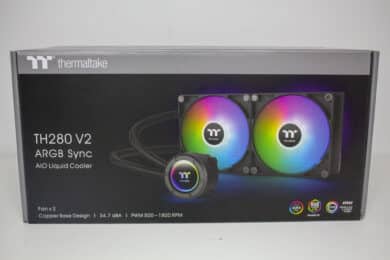
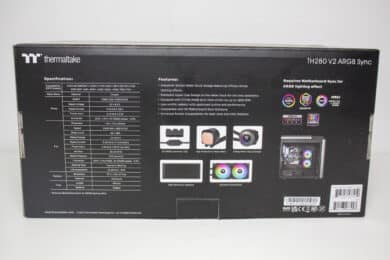

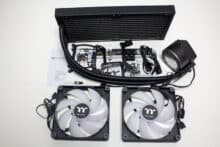
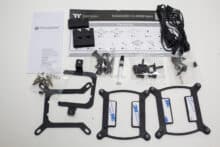
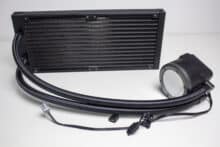

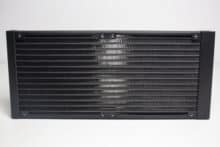
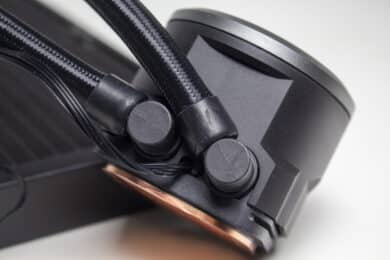


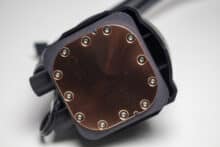


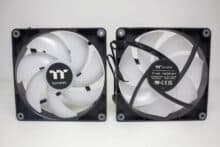
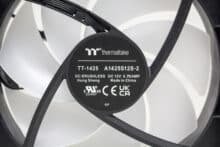

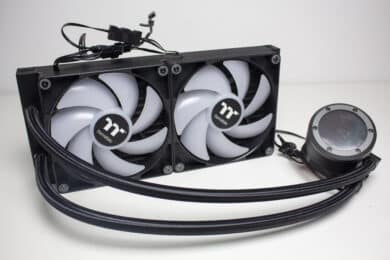

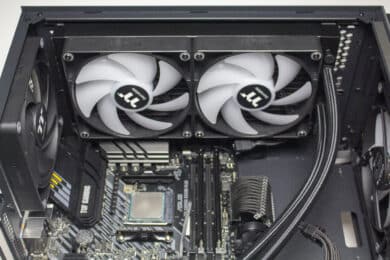

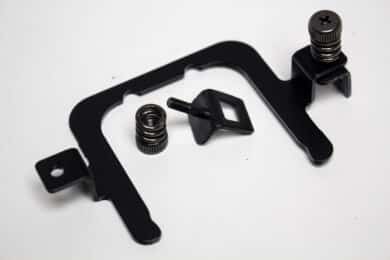



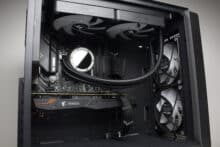


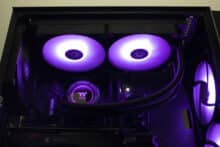
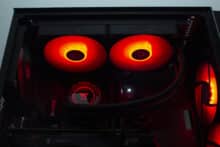
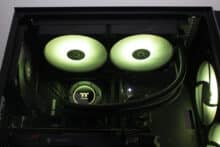

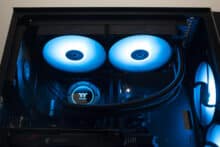
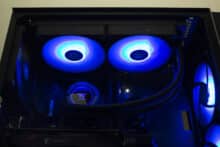
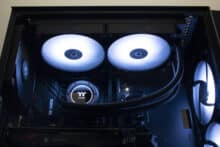
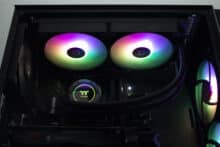
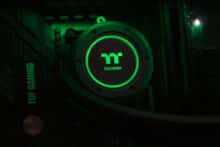



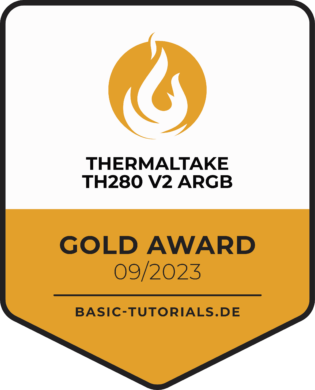



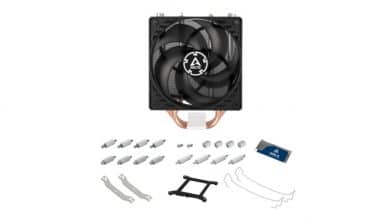
No replies yet
Neue Antworten laden...
Gehört zum Inventar
Beteilige dich an der Diskussion in der Basic Tutorials Community →